Report on Human Factors in Aviation Management: Stress and Decisions
VerifiedAdded on 2023/03/30
|8
|1664
|409
Report
AI Summary
This aviation management report explores the critical role of human factors, such as decision-making, communication, and environmental influences, on the performance of aviation personnel. It highlights the impact of stress on pilots, particularly during critical situations like take-offs and landings, referencing the Las Palmas incident as a case study. The report emphasizes the importance of stress mitigation strategies, adequate fuel reserves, and comprehensive crew resource management (CRM) to enhance safety and reduce accident rates. It also addresses issues related to crew training, communication clarity, and airport maintenance, underscoring the need for continuous improvement in these areas to minimize human error and improve overall aviation safety. Desklib offers this report as part of its resources for students studying aviation management, providing access to past papers and solved assignments.
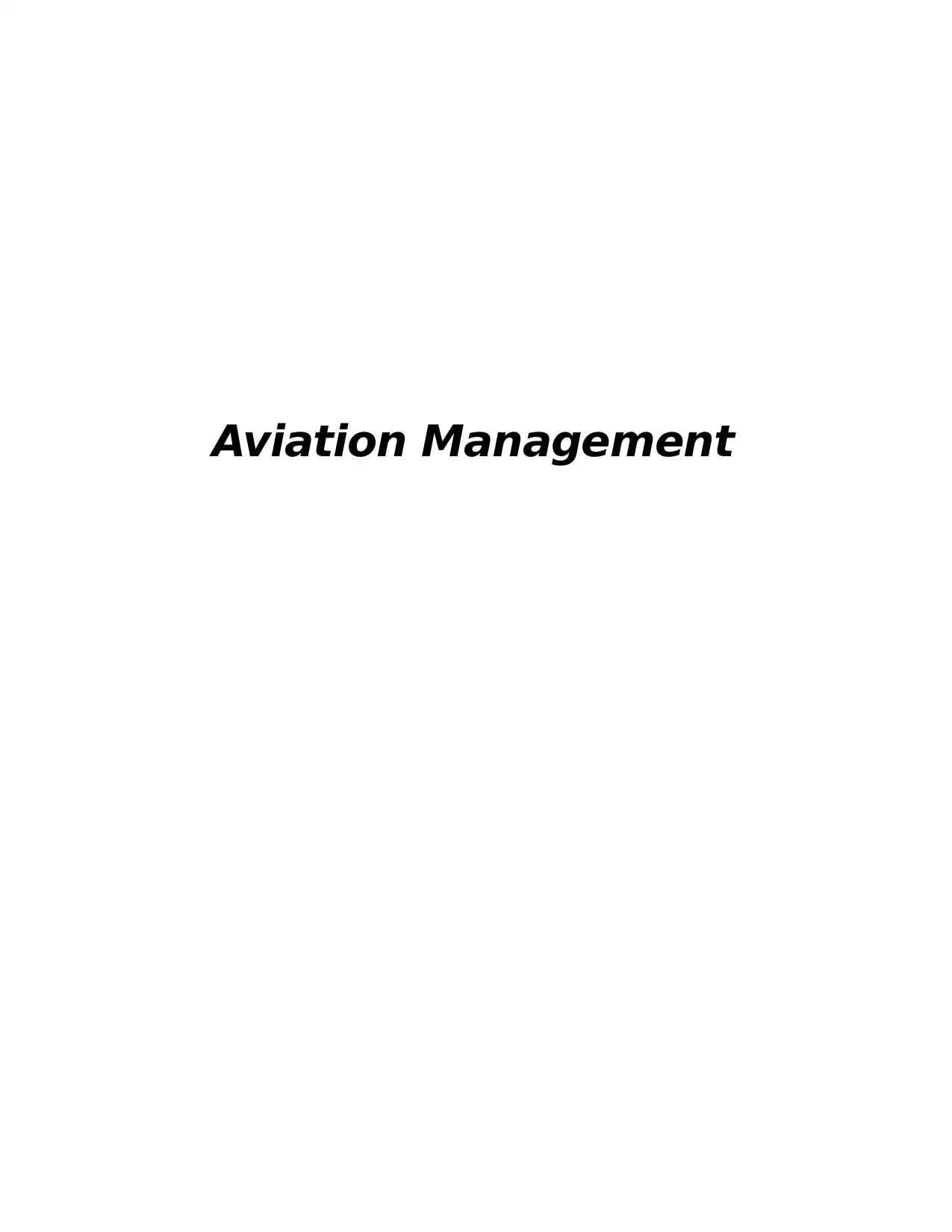
Aviation Management
Paraphrase This Document
Need a fresh take? Get an instant paraphrase of this document with our AI Paraphraser
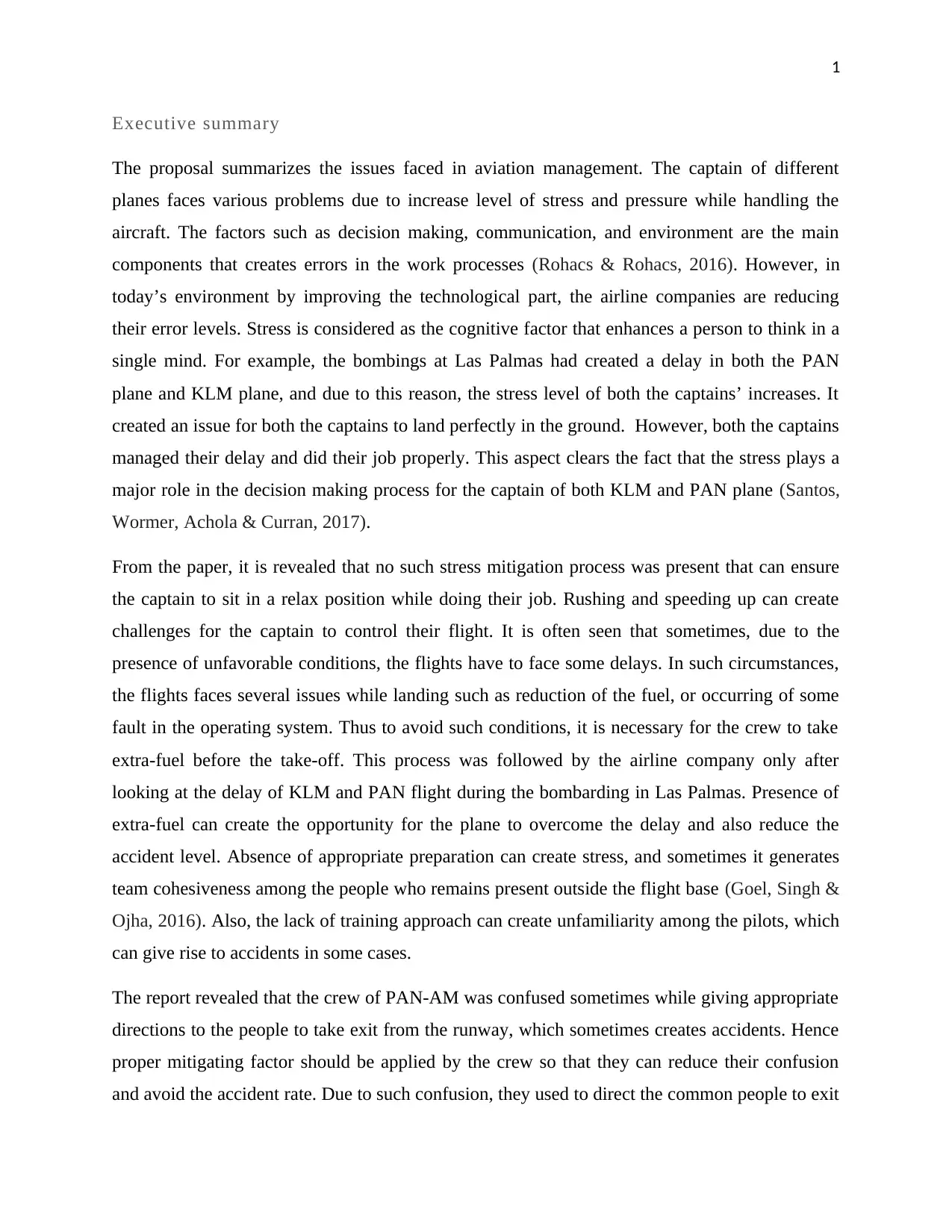
1
Executive summary
The proposal summarizes the issues faced in aviation management. The captain of different
planes faces various problems due to increase level of stress and pressure while handling the
aircraft. The factors such as decision making, communication, and environment are the main
components that creates errors in the work processes (Rohacs & Rohacs, 2016). However, in
today’s environment by improving the technological part, the airline companies are reducing
their error levels. Stress is considered as the cognitive factor that enhances a person to think in a
single mind. For example, the bombings at Las Palmas had created a delay in both the PAN
plane and KLM plane, and due to this reason, the stress level of both the captains’ increases. It
created an issue for both the captains to land perfectly in the ground. However, both the captains
managed their delay and did their job properly. This aspect clears the fact that the stress plays a
major role in the decision making process for the captain of both KLM and PAN plane (Santos,
Wormer, Achola & Curran, 2017).
From the paper, it is revealed that no such stress mitigation process was present that can ensure
the captain to sit in a relax position while doing their job. Rushing and speeding up can create
challenges for the captain to control their flight. It is often seen that sometimes, due to the
presence of unfavorable conditions, the flights have to face some delays. In such circumstances,
the flights faces several issues while landing such as reduction of the fuel, or occurring of some
fault in the operating system. Thus to avoid such conditions, it is necessary for the crew to take
extra-fuel before the take-off. This process was followed by the airline company only after
looking at the delay of KLM and PAN flight during the bombarding in Las Palmas. Presence of
extra-fuel can create the opportunity for the plane to overcome the delay and also reduce the
accident level. Absence of appropriate preparation can create stress, and sometimes it generates
team cohesiveness among the people who remains present outside the flight base (Goel, Singh &
Ojha, 2016). Also, the lack of training approach can create unfamiliarity among the pilots, which
can give rise to accidents in some cases.
The report revealed that the crew of PAN-AM was confused sometimes while giving appropriate
directions to the people to take exit from the runway, which sometimes creates accidents. Hence
proper mitigating factor should be applied by the crew so that they can reduce their confusion
and avoid the accident rate. Due to such confusion, they used to direct the common people to exit
Executive summary
The proposal summarizes the issues faced in aviation management. The captain of different
planes faces various problems due to increase level of stress and pressure while handling the
aircraft. The factors such as decision making, communication, and environment are the main
components that creates errors in the work processes (Rohacs & Rohacs, 2016). However, in
today’s environment by improving the technological part, the airline companies are reducing
their error levels. Stress is considered as the cognitive factor that enhances a person to think in a
single mind. For example, the bombings at Las Palmas had created a delay in both the PAN
plane and KLM plane, and due to this reason, the stress level of both the captains’ increases. It
created an issue for both the captains to land perfectly in the ground. However, both the captains
managed their delay and did their job properly. This aspect clears the fact that the stress plays a
major role in the decision making process for the captain of both KLM and PAN plane (Santos,
Wormer, Achola & Curran, 2017).
From the paper, it is revealed that no such stress mitigation process was present that can ensure
the captain to sit in a relax position while doing their job. Rushing and speeding up can create
challenges for the captain to control their flight. It is often seen that sometimes, due to the
presence of unfavorable conditions, the flights have to face some delays. In such circumstances,
the flights faces several issues while landing such as reduction of the fuel, or occurring of some
fault in the operating system. Thus to avoid such conditions, it is necessary for the crew to take
extra-fuel before the take-off. This process was followed by the airline company only after
looking at the delay of KLM and PAN flight during the bombarding in Las Palmas. Presence of
extra-fuel can create the opportunity for the plane to overcome the delay and also reduce the
accident level. Absence of appropriate preparation can create stress, and sometimes it generates
team cohesiveness among the people who remains present outside the flight base (Goel, Singh &
Ojha, 2016). Also, the lack of training approach can create unfamiliarity among the pilots, which
can give rise to accidents in some cases.
The report revealed that the crew of PAN-AM was confused sometimes while giving appropriate
directions to the people to take exit from the runway, which sometimes creates accidents. Hence
proper mitigating factor should be applied by the crew so that they can reduce their confusion
and avoid the accident rate. Due to such confusion, they used to direct the common people to exit
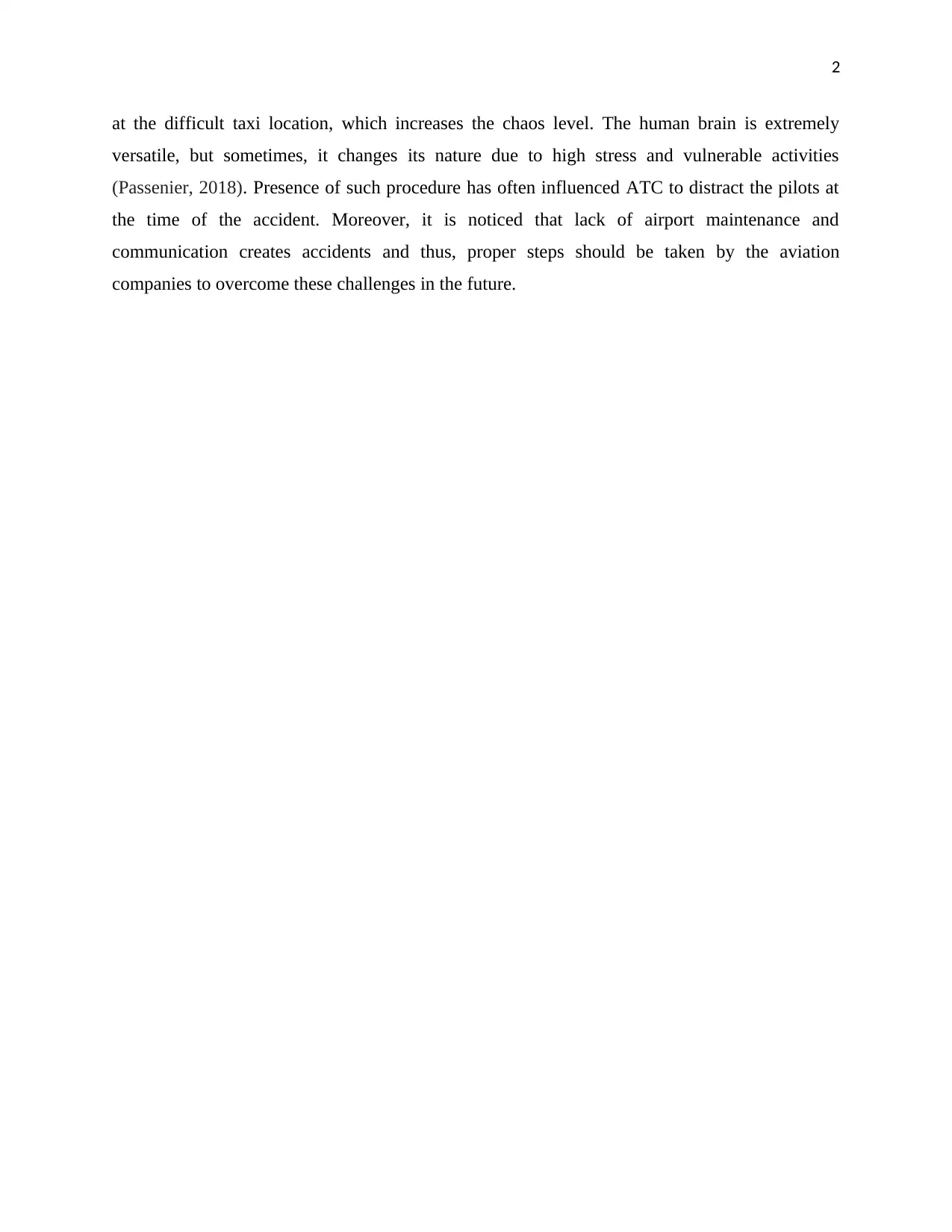
2
at the difficult taxi location, which increases the chaos level. The human brain is extremely
versatile, but sometimes, it changes its nature due to high stress and vulnerable activities
(Passenier, 2018). Presence of such procedure has often influenced ATC to distract the pilots at
the time of the accident. Moreover, it is noticed that lack of airport maintenance and
communication creates accidents and thus, proper steps should be taken by the aviation
companies to overcome these challenges in the future.
at the difficult taxi location, which increases the chaos level. The human brain is extremely
versatile, but sometimes, it changes its nature due to high stress and vulnerable activities
(Passenier, 2018). Presence of such procedure has often influenced ATC to distract the pilots at
the time of the accident. Moreover, it is noticed that lack of airport maintenance and
communication creates accidents and thus, proper steps should be taken by the aviation
companies to overcome these challenges in the future.
⊘ This is a preview!⊘
Do you want full access?
Subscribe today to unlock all pages.

Trusted by 1+ million students worldwide

3
Table of Contents
Introduction.................................................................................................................................................4
Conclusion...................................................................................................................................................5
References...................................................................................................................................................7
Table of Contents
Introduction.................................................................................................................................................4
Conclusion...................................................................................................................................................5
References...................................................................................................................................................7
Paraphrase This Document
Need a fresh take? Get an instant paraphrase of this document with our AI Paraphraser
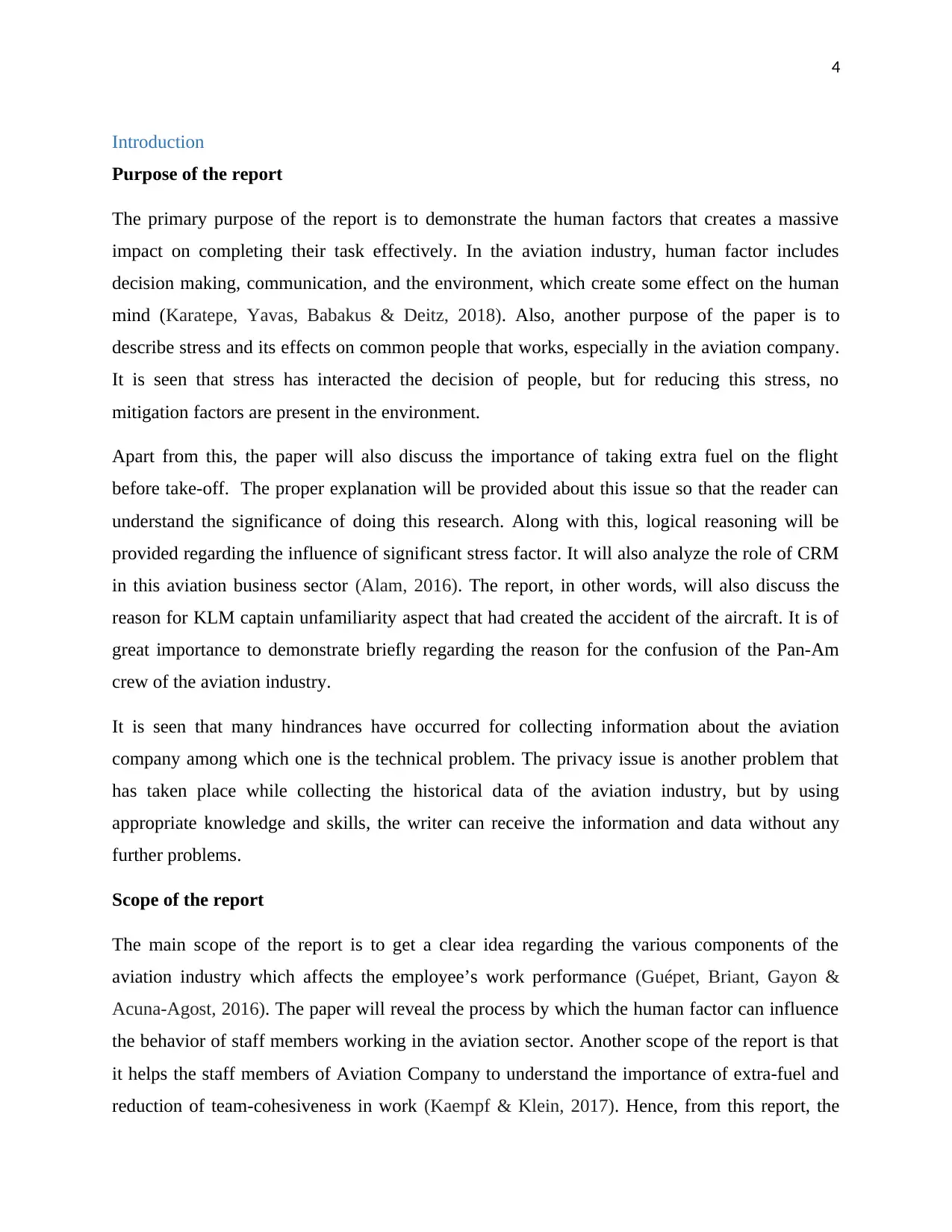
4
Introduction
Purpose of the report
The primary purpose of the report is to demonstrate the human factors that creates a massive
impact on completing their task effectively. In the aviation industry, human factor includes
decision making, communication, and the environment, which create some effect on the human
mind (Karatepe, Yavas, Babakus & Deitz, 2018). Also, another purpose of the paper is to
describe stress and its effects on common people that works, especially in the aviation company.
It is seen that stress has interacted the decision of people, but for reducing this stress, no
mitigation factors are present in the environment.
Apart from this, the paper will also discuss the importance of taking extra fuel on the flight
before take-off. The proper explanation will be provided about this issue so that the reader can
understand the significance of doing this research. Along with this, logical reasoning will be
provided regarding the influence of significant stress factor. It will also analyze the role of CRM
in this aviation business sector (Alam, 2016). The report, in other words, will also discuss the
reason for KLM captain unfamiliarity aspect that had created the accident of the aircraft. It is of
great importance to demonstrate briefly regarding the reason for the confusion of the Pan-Am
crew of the aviation industry.
It is seen that many hindrances have occurred for collecting information about the aviation
company among which one is the technical problem. The privacy issue is another problem that
has taken place while collecting the historical data of the aviation industry, but by using
appropriate knowledge and skills, the writer can receive the information and data without any
further problems.
Scope of the report
The main scope of the report is to get a clear idea regarding the various components of the
aviation industry which affects the employee’s work performance (Guépet, Briant, Gayon &
Acuna-Agost, 2016). The paper will reveal the process by which the human factor can influence
the behavior of staff members working in the aviation sector. Another scope of the report is that
it helps the staff members of Aviation Company to understand the importance of extra-fuel and
reduction of team-cohesiveness in work (Kaempf & Klein, 2017). Hence, from this report, the
Introduction
Purpose of the report
The primary purpose of the report is to demonstrate the human factors that creates a massive
impact on completing their task effectively. In the aviation industry, human factor includes
decision making, communication, and the environment, which create some effect on the human
mind (Karatepe, Yavas, Babakus & Deitz, 2018). Also, another purpose of the paper is to
describe stress and its effects on common people that works, especially in the aviation company.
It is seen that stress has interacted the decision of people, but for reducing this stress, no
mitigation factors are present in the environment.
Apart from this, the paper will also discuss the importance of taking extra fuel on the flight
before take-off. The proper explanation will be provided about this issue so that the reader can
understand the significance of doing this research. Along with this, logical reasoning will be
provided regarding the influence of significant stress factor. It will also analyze the role of CRM
in this aviation business sector (Alam, 2016). The report, in other words, will also discuss the
reason for KLM captain unfamiliarity aspect that had created the accident of the aircraft. It is of
great importance to demonstrate briefly regarding the reason for the confusion of the Pan-Am
crew of the aviation industry.
It is seen that many hindrances have occurred for collecting information about the aviation
company among which one is the technical problem. The privacy issue is another problem that
has taken place while collecting the historical data of the aviation industry, but by using
appropriate knowledge and skills, the writer can receive the information and data without any
further problems.
Scope of the report
The main scope of the report is to get a clear idea regarding the various components of the
aviation industry which affects the employee’s work performance (Guépet, Briant, Gayon &
Acuna-Agost, 2016). The paper will reveal the process by which the human factor can influence
the behavior of staff members working in the aviation sector. Another scope of the report is that
it helps the staff members of Aviation Company to understand the importance of extra-fuel and
reduction of team-cohesiveness in work (Kaempf & Klein, 2017). Hence, from this report, the
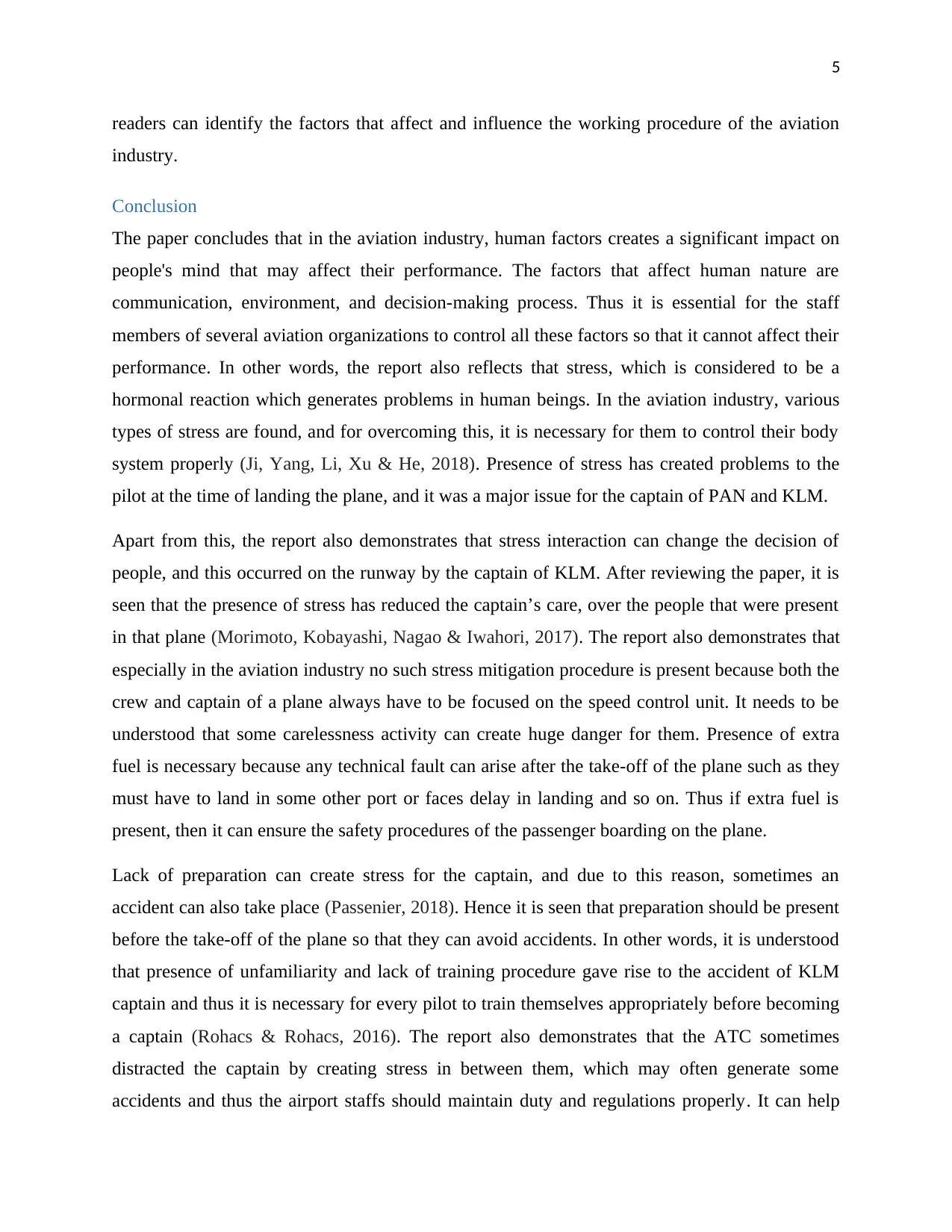
5
readers can identify the factors that affect and influence the working procedure of the aviation
industry.
Conclusion
The paper concludes that in the aviation industry, human factors creates a significant impact on
people's mind that may affect their performance. The factors that affect human nature are
communication, environment, and decision-making process. Thus it is essential for the staff
members of several aviation organizations to control all these factors so that it cannot affect their
performance. In other words, the report also reflects that stress, which is considered to be a
hormonal reaction which generates problems in human beings. In the aviation industry, various
types of stress are found, and for overcoming this, it is necessary for them to control their body
system properly (Ji, Yang, Li, Xu & He, 2018). Presence of stress has created problems to the
pilot at the time of landing the plane, and it was a major issue for the captain of PAN and KLM.
Apart from this, the report also demonstrates that stress interaction can change the decision of
people, and this occurred on the runway by the captain of KLM. After reviewing the paper, it is
seen that the presence of stress has reduced the captain’s care, over the people that were present
in that plane (Morimoto, Kobayashi, Nagao & Iwahori, 2017). The report also demonstrates that
especially in the aviation industry no such stress mitigation procedure is present because both the
crew and captain of a plane always have to be focused on the speed control unit. It needs to be
understood that some carelessness activity can create huge danger for them. Presence of extra
fuel is necessary because any technical fault can arise after the take-off of the plane such as they
must have to land in some other port or faces delay in landing and so on. Thus if extra fuel is
present, then it can ensure the safety procedures of the passenger boarding on the plane.
Lack of preparation can create stress for the captain, and due to this reason, sometimes an
accident can also take place (Passenier, 2018). Hence it is seen that preparation should be present
before the take-off of the plane so that they can avoid accidents. In other words, it is understood
that presence of unfamiliarity and lack of training procedure gave rise to the accident of KLM
captain and thus it is necessary for every pilot to train themselves appropriately before becoming
a captain (Rohacs & Rohacs, 2016). The report also demonstrates that the ATC sometimes
distracted the captain by creating stress in between them, which may often generate some
accidents and thus the airport staffs should maintain duty and regulations properly. It can help
readers can identify the factors that affect and influence the working procedure of the aviation
industry.
Conclusion
The paper concludes that in the aviation industry, human factors creates a significant impact on
people's mind that may affect their performance. The factors that affect human nature are
communication, environment, and decision-making process. Thus it is essential for the staff
members of several aviation organizations to control all these factors so that it cannot affect their
performance. In other words, the report also reflects that stress, which is considered to be a
hormonal reaction which generates problems in human beings. In the aviation industry, various
types of stress are found, and for overcoming this, it is necessary for them to control their body
system properly (Ji, Yang, Li, Xu & He, 2018). Presence of stress has created problems to the
pilot at the time of landing the plane, and it was a major issue for the captain of PAN and KLM.
Apart from this, the report also demonstrates that stress interaction can change the decision of
people, and this occurred on the runway by the captain of KLM. After reviewing the paper, it is
seen that the presence of stress has reduced the captain’s care, over the people that were present
in that plane (Morimoto, Kobayashi, Nagao & Iwahori, 2017). The report also demonstrates that
especially in the aviation industry no such stress mitigation procedure is present because both the
crew and captain of a plane always have to be focused on the speed control unit. It needs to be
understood that some carelessness activity can create huge danger for them. Presence of extra
fuel is necessary because any technical fault can arise after the take-off of the plane such as they
must have to land in some other port or faces delay in landing and so on. Thus if extra fuel is
present, then it can ensure the safety procedures of the passenger boarding on the plane.
Lack of preparation can create stress for the captain, and due to this reason, sometimes an
accident can also take place (Passenier, 2018). Hence it is seen that preparation should be present
before the take-off of the plane so that they can avoid accidents. In other words, it is understood
that presence of unfamiliarity and lack of training procedure gave rise to the accident of KLM
captain and thus it is necessary for every pilot to train themselves appropriately before becoming
a captain (Rohacs & Rohacs, 2016). The report also demonstrates that the ATC sometimes
distracted the captain by creating stress in between them, which may often generate some
accidents and thus the airport staffs should maintain duty and regulations properly. It can help
⊘ This is a preview!⊘
Do you want full access?
Subscribe today to unlock all pages.

Trusted by 1+ million students worldwide

6
them to reduce their stress, team cohesiveness, error, and accident rate as well as it reduces the
communication barriers of staff members working in an aviation organization.
them to reduce their stress, team cohesiveness, error, and accident rate as well as it reduces the
communication barriers of staff members working in an aviation organization.
Paraphrase This Document
Need a fresh take? Get an instant paraphrase of this document with our AI Paraphraser
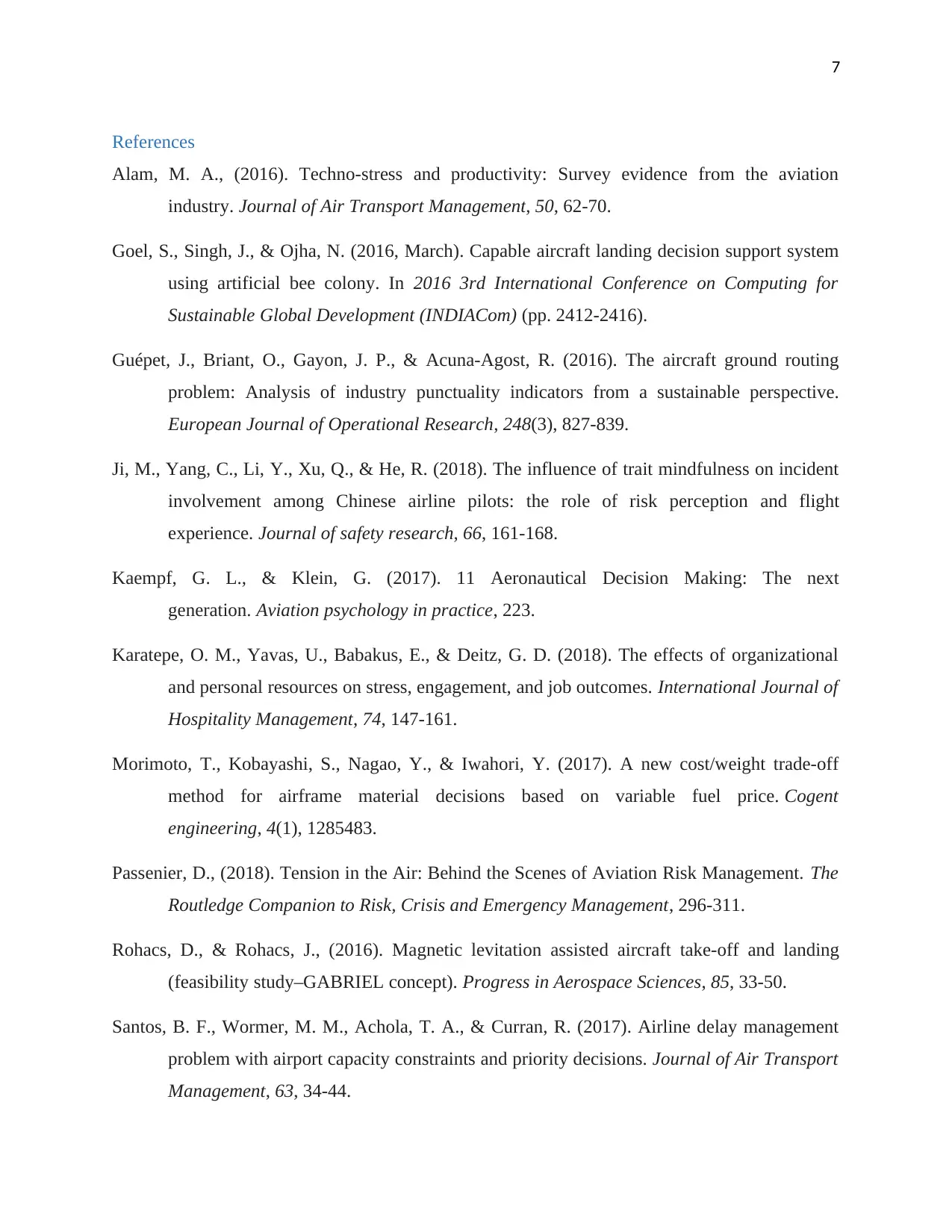
7
References
Alam, M. A., (2016). Techno-stress and productivity: Survey evidence from the aviation
industry. Journal of Air Transport Management, 50, 62-70.
Goel, S., Singh, J., & Ojha, N. (2016, March). Capable aircraft landing decision support system
using artificial bee colony. In 2016 3rd International Conference on Computing for
Sustainable Global Development (INDIACom) (pp. 2412-2416).
Guépet, J., Briant, O., Gayon, J. P., & Acuna-Agost, R. (2016). The aircraft ground routing
problem: Analysis of industry punctuality indicators from a sustainable perspective.
European Journal of Operational Research, 248(3), 827-839.
Ji, M., Yang, C., Li, Y., Xu, Q., & He, R. (2018). The influence of trait mindfulness on incident
involvement among Chinese airline pilots: the role of risk perception and flight
experience. Journal of safety research, 66, 161-168.
Kaempf, G. L., & Klein, G. (2017). 11 Aeronautical Decision Making: The next
generation. Aviation psychology in practice, 223.
Karatepe, O. M., Yavas, U., Babakus, E., & Deitz, G. D. (2018). The effects of organizational
and personal resources on stress, engagement, and job outcomes. International Journal of
Hospitality Management, 74, 147-161.
Morimoto, T., Kobayashi, S., Nagao, Y., & Iwahori, Y. (2017). A new cost/weight trade-off
method for airframe material decisions based on variable fuel price. Cogent
engineering, 4(1), 1285483.
Passenier, D., (2018). Tension in the Air: Behind the Scenes of Aviation Risk Management. The
Routledge Companion to Risk, Crisis and Emergency Management, 296-311.
Rohacs, D., & Rohacs, J., (2016). Magnetic levitation assisted aircraft take-off and landing
(feasibility study–GABRIEL concept). Progress in Aerospace Sciences, 85, 33-50.
Santos, B. F., Wormer, M. M., Achola, T. A., & Curran, R. (2017). Airline delay management
problem with airport capacity constraints and priority decisions. Journal of Air Transport
Management, 63, 34-44.
References
Alam, M. A., (2016). Techno-stress and productivity: Survey evidence from the aviation
industry. Journal of Air Transport Management, 50, 62-70.
Goel, S., Singh, J., & Ojha, N. (2016, March). Capable aircraft landing decision support system
using artificial bee colony. In 2016 3rd International Conference on Computing for
Sustainable Global Development (INDIACom) (pp. 2412-2416).
Guépet, J., Briant, O., Gayon, J. P., & Acuna-Agost, R. (2016). The aircraft ground routing
problem: Analysis of industry punctuality indicators from a sustainable perspective.
European Journal of Operational Research, 248(3), 827-839.
Ji, M., Yang, C., Li, Y., Xu, Q., & He, R. (2018). The influence of trait mindfulness on incident
involvement among Chinese airline pilots: the role of risk perception and flight
experience. Journal of safety research, 66, 161-168.
Kaempf, G. L., & Klein, G. (2017). 11 Aeronautical Decision Making: The next
generation. Aviation psychology in practice, 223.
Karatepe, O. M., Yavas, U., Babakus, E., & Deitz, G. D. (2018). The effects of organizational
and personal resources on stress, engagement, and job outcomes. International Journal of
Hospitality Management, 74, 147-161.
Morimoto, T., Kobayashi, S., Nagao, Y., & Iwahori, Y. (2017). A new cost/weight trade-off
method for airframe material decisions based on variable fuel price. Cogent
engineering, 4(1), 1285483.
Passenier, D., (2018). Tension in the Air: Behind the Scenes of Aviation Risk Management. The
Routledge Companion to Risk, Crisis and Emergency Management, 296-311.
Rohacs, D., & Rohacs, J., (2016). Magnetic levitation assisted aircraft take-off and landing
(feasibility study–GABRIEL concept). Progress in Aerospace Sciences, 85, 33-50.
Santos, B. F., Wormer, M. M., Achola, T. A., & Curran, R. (2017). Airline delay management
problem with airport capacity constraints and priority decisions. Journal of Air Transport
Management, 63, 34-44.
1 out of 8
Your All-in-One AI-Powered Toolkit for Academic Success.
+13062052269
info@desklib.com
Available 24*7 on WhatsApp / Email
![[object Object]](/_next/static/media/star-bottom.7253800d.svg)
Unlock your academic potential
Copyright © 2020–2025 A2Z Services. All Rights Reserved. Developed and managed by ZUCOL.
